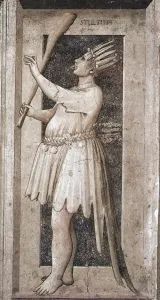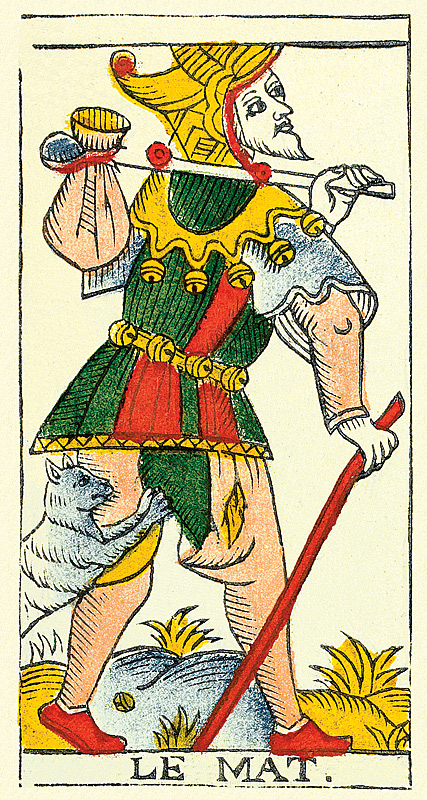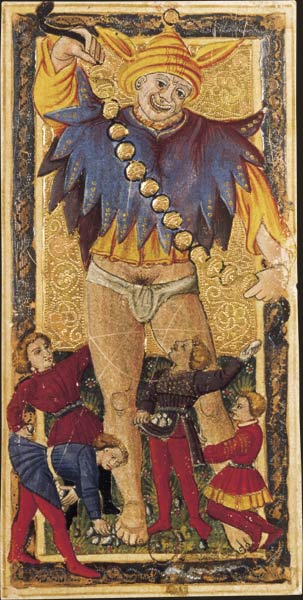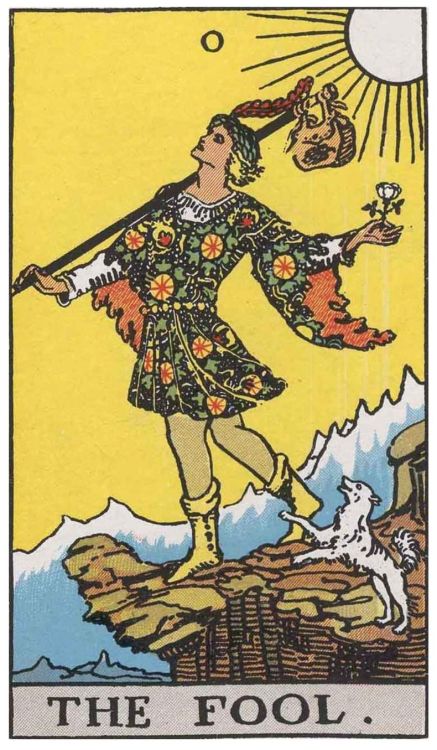

Misery and wandering are often depicted by figures accompanied by dogs and carrying sacks, sticks, and wearing tattered clothes. Fools do not appear before the 14th century with their jester costumes: hoods and bells, mock scepters, and donkey hats. The donkey symbolizes ignorance and the base instincts of man. At court, the fool is the one who has power over the king, the privilege to say what others cannot. He counterbalances flattery. Madness is also synonymous with possession and sin. Jacques de Voragine reports that one day, Saint Bartholomew miraculously healed the daughter of King Polymnius, who had gone mad and was so dangerous to others that she was chained. Bartholomew removed her chains and said, "Fear not, I have already chained the demon that was in her." This is a very clear glimpse of the medieval amalgam between madness and demonic possession.
Erasmus emphasizes the importance of fools to kings in *The Praise of Folly*. The greatest kings are so fond of them that many would not sit down to eat or take a step without them, nor be without them for an hour. They value fools more than the austere sages they keep around for show. Fools provide what princes seek everywhere at any cost: amusement, smiles, laughter, pleasure. But Erasmus also makes some allusions to a second role attributed to fools, that of a revealer, a grotesque mirror, a role evidenced by the fact that fools underwent real training, which was more suited to men of wit than to real idiots. It seems that certain discreet associations were not unrelated to this, according to Bernard Roger in his book *À la découverte de l'alchimie*. The fool was therefore not a simpleton, but more of a scholar capable of witticisms that could amuse his lord. He dared to say out loud what the courtiers thought quietly. The fool had the freedom and mischievousness to be what the courtiers refused to be.
Originally, the scepter was an attribute of court jesters and symbolized madness. The fool, in the sense of a jester, becomes the emblem of an upside-down world, a representation of the end-of-times anxiety, fed by famines, epidemics, and the religious crisis that began in the 14th century, which settled at the heart of Western society. The paintings of danse macabre, where the chariot of death crushes both the powerful and the humble alike, express a religious but also moral disarray. The world is mad and heading for its downfall. It lives in sin, and sin is madness, beyond even the metaphor, in the sense that the Old Testament equates the two. The fool, the non-wise, lives in blasphemy and sin.
In the past, misery and wandering were often depicted by men in tattered clothes, accompanied by dogs, with a sack as their only possession. It could be said that such men lived in sin, and that sin was madness.
The parable of the lost sheep, also known as the parable of the good shepherd or the good pastor, attributed to Jesus of Nazareth, is found in two canonical gospels of the New Testament. It is reported by Matthew and Luke, and is also found in the apocryphal Gospel of Thomas. In the Gospel according to Luke, chapter 15, verses 4 to 7, it reads: "What man of you, having a hundred sheep, if he loses one of them, does not leave the ninety-nine in the wilderness, and go after that which is lost until he finds it? And when he has found it, he lays it on his shoulders, rejoicing. And when he comes home, he calls together his friends and neighbors, saying to them, Rejoice with me, for I have found my sheep which was lost. Likewise, I say unto you, there will be more joy in heaven over one sinner that repents, than over ninety-nine righteous persons who do not need repentance."
This means that the fool, despite his wanderings and faults, is all the more deserving of returning to the right path because he has traveled the detours. Glory is measured by the failures from which one has risen, not by the righteous causes one has accomplished. In this, the fool warns that the path may be rough, but that freedom comes at this price.
Aristotle distinguishes between those who are dangerously mad, melancholic, and who have lost their minds, and those who, despite their madness, still possess some intelligence. The mad, of all types, act impulsively, without considering the consequences, and do not heed advice. They lack prudence, the ability to discern truth from lies, good from evil, to learn from the past, and to prepare in advance. At the time the tarot was invented, the mentally ill were classified into two categories: the dangerous, who needed to be confined for the safety of all, and the innocent, the simple-minded.
Mental issues were often attributed to humors that were too cold or moist, thickening and slowing down the brain fluids, making the individual susceptible to demonic possession. Those afflicted with madness had no legal rights and were considered outsiders with no place in the social hierarchy. This is precisely the role of the fool in tarot: without rank or power, he can nonetheless appear anywhere, mimicking any card, which paradoxically makes him one of the most valuable cards in the deck.
The fool card in the Visconti-Sforza deck is similar to the figure of Folly painted by Giotto in 1305 in the Scrovegni Chapel. Here, virtues and vices face off on opposite walls. Stultitia (stupidity or lack of reason) is opposed to prudence, which symbolizes reasonableness and foresight.
Like the fool in the Visconti-Sforza, this allegorical figure wears feathers on his head, is dressed in rags, and uses a large stick to fend off dogs. His deformed body symbolizes a deficient mind, and his closed mouth suggests he has nothing reasonable to say. The text titled "Le Fiore di Virtù," written in the early 14th century, describes pairs of virtues and vices. This text was published in many editions from the 14th to the 18th century and translated into several languages.
In the popular cards played by the population, the fool was depicted as a wandering man, often with a stick in hand. He wore a hat adorned with bells.
Wandering beggars were a common sight during the Renaissance, often depicted in art. The wandering man drawn by Bosch in 1510 shows a traveler with all the attributes of the tarot of Marseille's fool. This man, dressed in rags, uses a long stick to fend off a dog. A Bolognese manuscript from 1750, discovered by researcher Franco Pratesi, provides the first written indication of the interpretation of the fool in cards. The keyword here is "madness," faithful to the early card images. The fool did not develop other attributes until the late 16th century when he evolved into a street performer or jester.
The master card makers of the French Renaissance chose to retain the name of the fool, while transforming this character into a jester, as recognized in medieval iconography. The fool in the tarot of Marseille has two aspects: below the waist, he is dressed in tattered clothes, harassed by a dog, still perceived as a social outcast. In Jean Noblet's Marseille tarot (1650), the fool even exposes his genitals, an allusion to late medieval representations.
In contrast, from the waist up, the fool is adorned with colors, with a collar and belt decorated with bells, and wears a stylized jester's hat. His long stick, to which a bundle is attached, suggests that he spends most of his time on the road. Is he a homeless beggar, unable to face responsibilities, or a jester, a street performer, traveling the roads between different shows and performances? Is his mind confused and his life disordered, or does he enjoy the freedom of the road, despising those who are trapped in their daily lives and conventions?
Starting with Pierre Madénié, the Fool card was renamed to "LE MAT".
The term "Mat" might be derived from the Italian word matto, meaning "fool" or "madman," which fits the spirit of the card. The word "mat" also comes from the Arabic māt, meaning "dead." In the context of chess, "checkmate" (from the Persian shāh māt) means "the king is dead." This expression has been adopted in many languages and influenced various terminologies, possibly including tarot. Indeed, there may have been confusion or a merging between the Italian matto (fool) and the Arabic mat (dead). This confusion could be intentional or accidental, but it led to the adoption of the term "Le Mat" in the Tarot of Marseille.
Referring to the Arabic meaning of mat: "the king is dead" (checkmate), French card masters may have intended to imply that the Fool, as the king's jester, was freed from his duties following the death of his king. He could then take to the roads with just a bundle on his shoulder, as depicted on the card. The name of this card evokes more of a free man rather than a madman, or perhaps a jester who no longer has a master.
In the evolution of tarot, the Fool has taken different forms and meanings depending on the regions and eras. In France, the Fool evolved into a wandering artist, often symbolizing a form of uncontrolled freedom. However, in Bologna, Italy, the image of the innocent simpleton was preserved. The Fool in the Mitelli Tarot is similar to this representation: he is an adult man, laughing, riding a stick like a child, surrounded by children, reminiscent of the Charles VI Tarot cards.
In Europe, the divinatory meanings of the Fool tend to be darker than in the Anglo-American world. These meanings include illusion, confusion, passive drifting, irresponsibility, and impulsive actions leading to chaos. At best, the card symbolizes radical freedom and a detachment from societal restrictions, allowing for a kind of creative genius.
Thus, the French occultist Eliphas Lévi, in his work Transcendental Magic, describes the Fool as a man dressed in rags, wandering aimlessly, symbolizing a disordered mind burdened by temptation and irrational impulses. According to Papus and Oswald Wirth, this Fool embodies a mental state of confusion, unable to resist impulses, leading to a life of drifting and danger. Arthur Waite deviated from this dark vision to create a brighter image: in the Rider-Waite-Smith Tarot, the Fool is a young man elegantly dressed, holding a rose and accompanied by a white dog, about to venture off a cliff. This cliff, far from being terrifying, seems to invite him to a new adventure, protected by invisible angels. This card is often interpreted as representing the quest for experience and the pursuit of the unknown.
However, the divinatory meanings associated with the Fool by Waite still include notions of madness, negligence, and danger, recalling older interpretations of the card.
On this card, we see an older man, as indicated by his baldness, standing in front of an ATM. He holds a credit card in one hand, while in the other, he hands a wad of cash to a hand that we imagine belongs to a woman. This representation of the Fool is very interesting because it seems like he is giving away all the money he has left to a stranger. We don't know why he does it, but perhaps he does it simply because he is mad. Here, madness could be interpreted as an inability to understand the value of things, to not realize the need to keep enough money to live and eat. In fact, he gives all his money to a stranger, and his smile indicates that he does so willingly, without any constraint. Thus, this madness is associated with a complete detachment from material possessions, perhaps even a form of extreme altruism or ignorance of the consequences.
One could also say that the madness here is represented by the act of squandering all his money, spending it recklessly. We know how important money is in our Western societies: it rules the world, and therefore our lives. How can one govern their own life if they have no money, when money allows us to "buy" a life? But perhaps, beyond the madness of this man, there is a dimension of freedom. Perhaps the author intended to say that giving up one's money can also be a synonym for freedom, because ultimately, when we have lost everything, we have nothing left to lose, and we are free to say and do whatever we want. In other words, this card could suggest that true freedom comes from the absence of possessions, from no longer being tied down by material constraints, and being open to a new form of life or personal quest.
The Fool card in the Vox Arcana Tarot features iconography that recalls more traditional tarot representations while adding unique elements. The Fool is depicted in a classic costume, with a stick over his shoulder carrying a bundle. Beside him, a feline creature bites him on the buttocks, while a dog barks alongside, reminiscent of the inspiration from the Rider-Waite-Smith Tarot.
Unlike other representations where the Fool appears carefree, here, he is a smiling young man, literally running at full speed as if he is sprinting. In one hand, he firmly holds his bundle, and with the other, he raises his hand to his forehead, giving the impression that he has just had a sudden realization or an epiphany. This gesture may indicate a moment of reflection or doubt about his path, although the exact nature of this realization remains mysterious.
A particularly interesting detail of this card is the presence of multiple keys flying through the air. These keys seem to be spilling out of the open bundle, as if they are being flung out by the Fool's frenzied run. Each of these keys is unique, suggesting that they unlock different doors. This indicates that the Fool possesses multiple solutions, a multitude of possibilities. However, the man does not seem concerned about losing his keys in his race, which can be seen as a form of abandonment. It is also possible that the Fool symbolizes the acceptance of leaving certain doors closed, signifying a form of wisdom or faith in the journey, even without all the answers.
This evokes the idea that the Fool's madness is linked to his indifference to the loss of these objects that symbolize understanding and the ability to unlock certain aspects of his life. One might see in this loss an allegory of abandoning intellectual understanding in favor of spiritual or emotional enlightenment. This young man seems to suggest that it is not so much about having all possible keys but rather finding the unique key that is his own, the one that opens the door to self-knowledge.
The background of the image is a blue sky dotted with clouds, reinforcing the idea of freedom. The young man may not be running on earth but in the sky, symbolizing a nearly divine or transcendent freedom. This can also be interpreted as a sign that the Fool, in his quest for freedom, is willing to sacrifice some answers, or that he finds comfort in not knowing them all.
Thus, the Fool is not only a symbol of carefreeness or wandering but also of a form of wisdom that comes from accepting the uncertainties of life. He invites us to consider that sometimes, the true key is the one we carry within us, a key that does not require answers to all questions, but a deep understanding of ourselves and our place in the universe.
The Fool card in the Sasuraibito Tarot offers a unique and intriguing interpretation of the traditional character. Here, we see a very old man, with a white beard so long that it almost touches the ground. This man is completely naked, and his beard seems to be his only garment.
This Fool appears joyful, performing a sort of light dance, an expression of his playful mood. Red flowers float around him in the air, stirred by an invisible wind, adding to the lighthearted and carefree atmosphere of the scene. The man seems to be enjoying the situation, reflecting an innocence and spontaneity rarely associated with someone of his age.
As in the previous "Exotic Cancer" Tarot card, this Fool seems stripped of all his attributes and material possessions. He lives naked, as on the first day of his life, possessing nothing. This representation reinforces the idea of total freedom, a return to the very essence of being.
The Fool's nudity can be interpreted as a symbol of the abandonment of the responsibilities and constraints associated with adult life. It could be the folly of a man rejecting adult reason, relinquishing the attributes of maturity to rediscover the innocence, joy, and spontaneity of childhood.
However, it is important to note that this abandonment of adult prerogatives could also be seen as a regression or an escape from responsibilities. Nudity can symbolize extreme vulnerability, exposing the man to the elements and external judgments. But, in this card, the emphasis seems more on the positivity of this approach, as if the folly ultimately lies in renouncing all social norms to return to the source, to the essence of who we are.
The Fool card in the Trionfi della Luna Tarot offers a particularly dark and complex interpretation. Here, the character is not clearly gendered, and wears a costume that could resemble that of an aristocrat, though it might also evoke that of a jester, with a cape that adds to this ambiguity.
Instead of carrying a staff with a bundle, the character holds a trident, a powerful symbol often associated with destructive forces. What's striking is that the character seems to have two faces: one at the front, and another at the back, drawn at the level of the buttocks, blowing flames. On his shoulder, a red imp whispers into his ear, creating palpable tension in the image. This whisper seems to worry the character, who grimaces and raises a hand to his face, as if in the throes of a dilemma. Meanwhile, he advances toward a fire covering the ground, as if heading towards the underworld.
The most intriguing element of this card is the imp, which could symbolize an inner voice. In traditional representations of madness, it is often said that the fool hears voices. Here, this inner voice, though diabolical, could be perceived as a manifestation of the character's soul's depth, a connection to their innermost essence.
Even though the image depicts this listening as dangerous, leading the character towards the fire, it may also represent a form of liberation. By listening to this inner voice, the Fool allows themselves to act according to their true nature, disconnecting from social conventions and expectations. This listening may lead to actions that seem crazy or inappropriate, but it also allows for the release of aspects of oneself that would otherwise remain buried.
However, it is important to note that this inner voice can be deceptive and lead the character into a self-destructive spiral. The fire towards which they walk could symbolize not only the destruction of social norms but also the burning of bridges with others, or even a complete loss of control.
Thus, the Fool card in the Trionfi della Luna reminds us that connecting with one's inner voice can be both an act of liberation and a perilous path. This process can reveal deep truths about oneself, but it also carries the risk of burning everything in its path, including what is precious.

Key words for the 78 cards for the Tarot of Marseille and the Rider-Waite-Smith, to slip into your favorite deck. Your leaflets always with you, at hand, to guide you in your readings. Thanks to them, your interpretations gain in richness and subtlety.
The Fool, contrary to what its name might suggest, is not truly mad. It’s important to understand that this card does not represent an irresponsible or dangerous person, although some might perceive it that way. The Fool is above all a free being, a spirit that respects no convention, no norm, no law. He refuses to conform to a predefined role. The Fool is seen as one who transcends social conventions and the limits imposed by society. He embodies a deep wisdom, often misunderstood by the outside world.
This is why the Fool has no number. While all the other cards of the major arcana in the Tarot of Marseille represent well-defined roles, the Fool embodies the character without a role, free from any function and obligation. He is free to do what he wants, where he wants, when he wants, and how he wants. In this context, "madness" could be interpreted as the act of fully accepting one’s individuality, embracing total freedom.
The Fool's journey through the major arcana symbolizes a process of personal realization and fulfillment. Freedom, here, is a central element.
The Fool's freedom could also be seen as a form of rebellion against established structures, making him both an inspiring and potentially subversive character. This total freedom can be perceived as a spiritual quest, where the Fool seeks to detach from the illusions of the material world.
The Fool could represent two different states:
The difference between wandering and freedom is subtle. It can be as thin as a thread and as wide as a thread, suggesting that this difference lies primarily in a state of mind. The Fool, as a symbol, reminds us that true freedom lies in our ability to transcend mental and spiritual limitations. This path to freedom can be seen as a state of spiritual awakening, where the Fool has understood the illusory nature of things and is able to navigate the world with serenity and inner independence.
| Symbolic interpretation | Right direction (Positive) | Pilgrimage, adventure, unknown, unconventional, impulse, spontaneity, joy of life, detachment | Reverse direction (Negative) | Exile, wandering, imbalance, insecurity, marginality, instability, mockery |
| Psychological interpretation | Right direction (Positive) | Extravagant, carefree, independent, original, rebellious | Reverse direction (Negative) | Incoherent, irresponsible, irrational, unreasonable, provocative, reckless, disoriented, inconsistent |
| Advice | |
| Learn to differentiate between limits that protect you and those that confine you. Learn the rules so you can better break free from them. Don’t take your actions too seriously. React with spontaneity. Stay in motion and action. Don’t fear bad luck. Move forward without looking back. Avoid routine and norms. Cast off the moorings. Abandon your possessions. Enjoy owning nothing. Travel without a goal. Detach from your bonds. Embrace the unknown. | |
| Thematic Interpretation | Love | Nonconformist love. Passion with no future. Chronic romantic instability | Work | Unexpected resignation or dismissal. Transfer far away. Risky or adventurous project or collaboration | Money | Risky investment with no visibility or guarantee. Loss or abandonment of wealth | Family / Friendships | Irregular relationship. Out of sight, out of mind. Interest elsewhere or in other matters. Spontaneous or festive gathering | Health | Unconventional therapeutic choice. Powerful but irregular energy. Risky behavior |
| Divination / Prediction | Who ? | A stranger. A free spirit. A joker. A clown. An outsider. A man with no faith or law | Where ? | On the road. At the station. In the fields. In a circus | When ? | Anytime. Unexpectedly or unpredictably. During a party. During a carnival. During a journey | How ? | By doing things differently. By letting go of everything. By choosing the unknown or the improbable |




















Copyright © TarotQuest.fr